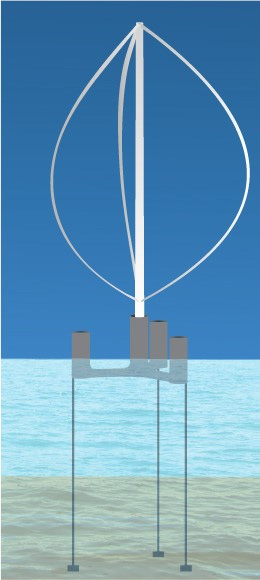Reducing the Cost of Floating Offshore Wind
Offshore wind is one of the largest untapped energy markets in the United States. The Department of Energy (DOE) estimates that wind turbines in the waters along the US coasts could produce more than double the amount of energy currently consumed by the entire US.
The most well-known offshore wind farms in the US are Block Island and the under-development Vineyard Wind and Ocean Wind projects. These are (and will be) located in shallow coastal waters, with their towers anchored to the sea floor. However, these favorable shallow sites will be quickly developed over the next decade on the East Coast and largely don’t exist on the West Coast where the sea floor falls off much more rapidly. How, then, can we maximize offshore wind energy’s huge potential?
If we look about 20 miles further out, there is another solution. Held in place by mooring cables and anchors, floating offshore wind turbines (FOWTs) present tremendous generation opportunities. They can be located where the winds blow the strongest, and because of the expansive space in the open waters, they can be spread further apart. More distance between the turbines reduces the efficiency degradations that can be found on tightly packed onshore and coastal wind farms, and it decreases the chance of negative wildlife impact.
But there’s a catch. FOWTs cost nearly twice as much as their coastal counterparts. That’s why Arctura has joined forces with the University of Texas at Dallas’ ATLANTIS development team. With a $3M grant from ARPA-E, the team is developing new technologies, materials, and design methods that will reduce the cost of deep-water offshore wind, making it a competitive and viable green energy solution.
Deep Water Turbines: Horizontal or Vertical Axis?
The primary goal of the ATLANTIS program is to reinvent the wind turbine to lower the cost of FOWTs. It’s tempting to try to apply our historical knowledge of turbine structures and converged onshore designs to the deep-water problem. After all, horizontal axis wind turbines (HAWTs), with their pinwheel style turbines mounted on tall towers work well onshore and in coastal waters. However, 20+ miles out to sea on floating platforms, they’re harder to manage and maintain because of their size, weight, and high center of gravity.
We think that there is a better approach. Vertical axis wind turbines (VAWTs) are much better suited to deep waters and have the potential to provide a low cost, scalable solution. They have a cylindrical shape and the blades rotate around a central shaft (think of the beater on a hand mixer). The generator and controls are located on the platform, putting the center of gravity much lower than with HAWTs, making maintenance easier. The platform itself is substantially smaller than what’s required for a HAWT, which dramatically reduces the total cost. In addition, VAWTs are insensitive to wind direction, reducing design complexity and maximizing energy capture over their operational lifetimes.
Contrary to popular belief, a properly designed VAWT can equal the efficiency of the HAWT in extracting power from the wind. The key technical challenge is to manage the highly varying aerodynamic loads experienced by the VAWT (the loads are much more variable than for a comparable HAWT), which can lead to fatigue and component failure. This is where Arctura, and the rest of the University of Texas at Dallas (UTD) team, is making in-roads.
Notional Floating Vertical Axis Wind Turbine.
Arctura and ATLANTIS
As a key member of the ATLANTIS team, Arctura is working to integrate our proprietary active lift control system on the VAWT’s blades. Our system makes turbine blades smarter with blade-integrated plasma actuators. Controlled by software, we can modify lift in real time by modulating the airflow around the blade. We’re currently testing the technology to quantify and verify its ability to reduce the cyclic loading and dynamic stall effects that currently result in variable loads. This, in turn, should reduce component fatigue and maximize the performance of floating offshore VAWTs.
This small prototype VAWT underwent testing at the University of Washington’s Kirsten wind tunnel. Shown in the photograph is an engineer from our ATLANTIS teammate XFlow Energy operating the tunnel.
Arctura’s plasma actuators were built into the leading edge of each blade. The plasma can be seen here emitting a faint purple glow.
This extended time exposure shows how the plasma actuators were turned on and off during each rotation.
Contact Arctura today to learn more about our active lift control technology, our work on FOWTs, and other exciting innovations our team is bringing to the wind industry.





